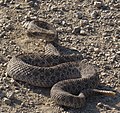Crotalus viridis
Crotalus viridis (commonly known as the prairie rattlesnake or desert rattlesnake) is a species of venomous Pit vipers. There is currently only six subspecies recognized, not including the nominate subspecies like the hopi, and others.
| Crotalus viridis | |
|---|---|
| Conservation status | |
| Scientific classification | |
| Kingdom: | Animalia |
| Phylum: | Chordata |
| Class: | Reptilia |
| Order: | Squamata |
| Family: | Viperidae |
| Genus: | Crotalus |
| Species: | C. viridis
|
| Binomial name | |
| Crotalus viridis (Rafinesque, 1818)
| |

| |
| Synonyms | |
| |
Description
The Prairie Rattlesnake usually grows up to the length of around 100 centimeters (3.3 ft). Prairie Rattlesnakes in Montana can sometimes grow up to the length of 120 centimeters (3.9 ft), but the longest ever found was 151.5 centimeters (4.97 ft) long. They are usually light brown in color with some patches of dark brown.
Feeding
Prairie Rattlesnakes eat mainly small mammals like ground squirrels, mice, rats, small rabbits, and prairie dogs. Young Prairie Rattlesnakes eat amphibians, and small reptiles.
Reproduction
Female Prairie Rattlesnakes are viviparous, and can give birth to around 3-25 young at a time. The young are born around between August and October.
Behavior
Prairie Rattlesnake are diurnal in cool weathers, and nocturnal in hot weathers. They have a very powerful and deadly venom which they only use if attacked. Like other rattlesnakes they shake their tail to make a rasping sound which warns enemies.
Common names
The Prairie Rattlesnake is also called the "Western Rattlesnake", the "Plains Rattlesnake", the "Black Rattler", the "Confluent Rattlesnake", the "Missouri Rattlesnake", the "Spotted Rattlesnake", the '' Desert Rattlesnake'', and the "Western Pacific Rattlesnake".
Where they live
It is also found in southwestern Canada, south to the United States of America, and northern Mexico. In Canada it is found in Alberta, and Saskatchewan, in the United States of America it is found in eastern Oregon, eastern Washington, southern Idaho, Montana, North Dakota, South Dakota, Wyoming, Nebraska, Colorado, Kansas, Oklahoma, Texas, New Mexico, and eastern Arizona, in Mexico it is found in northern Coahuila, and northwestern Chihuahua.
Subspecies
Not including the nominate subspecies, Crotalus Viridis Viridis, the Prairie Rattlesnake only has one subspecies: the "Hopi Rattlesnake" (Crotalus Viridis Nuntius) which is found in northeastern and north-central Arizona, and New Mexico.
Crotalus Viridis Media
References
- ↑ Frost, D.R.; Hammerson, G.A. & Santos-Barrera, G. (2007). "Crotalus viridis". IUCN Red List of Threatened Species. IUCN. 2007: e.T64339A12771847. doi:10.2305/IUCN.UK.2007.RLTS.T64339A12771847.en.
- ↑ McDiarmid RW, Campbell JA, Touré TA. 1999. Snake Species of the World: A Taxonomic and Geographic Reference, Volume 1. Washington, District of Columbia: Herpetologists' League. 511 pp. ISBN 1-893777-00-6 (series). ISBN 1-893777-01-4 (volume).









